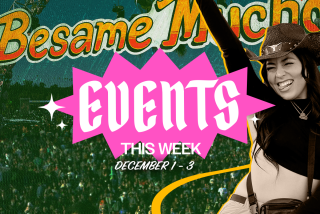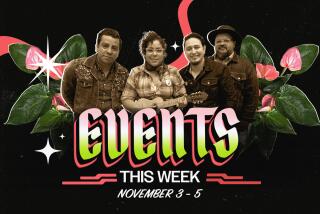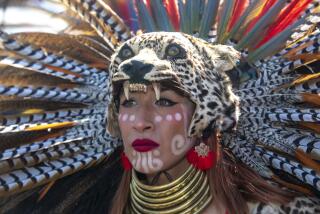Hawaiian Festival brings sights and sounds of the Islands to Lawndale.
- Share via
Alondra Park may be in Lawndale, but this weekend, it could be mistaken for an island in the Pacific.
Booths will be decorated with palms and ti leaves; poi and pig will be among luau delicacies offered by food vendors, and dancers accompanied by guitars will tell stories of ancient wars and legends.
It’s the Hawaiian Festival, which originated in Los Angeles County 11 years ago “so that people from Hawaii could get together at least once a year,” said Co-Chairman George Ichiama. The free celebration brings ethnic color to Alondra on Saturday and Sunday, starting at 10 a.m. each day.
Despite its name, the festival--which Ichiama said should draw 80,000 people over both days--is a celebration of many Polynesian cultures. Continuous entertainment on a central stage will present dances of Hawaii, Tahiti, Samoa, Fiji and Tonga.
And the festival--a kind of homecoming for Southland Hawaiians--gives mainlanders a weekend immersion in the Pacific world.
Sissy Kaio, who operates a Hawaiian dance school in Carson, calls the festival a great opportunity “for lots of people who are interested in our culture.”
Her dancers will perform traditional and modern hulas--the Hawaiian word for dances--in which stories are told through body movements and facial expressions. Kaio’s school--Na Pua Me Kealoah, meaning “the young ones with love”--also will teach Hawaiian arts and crafts at a festival booth.
Other Hawaiian festivals are held elsewhere, Ichiama said, but the one at Alondra is the largest outside of Hawaii. First staged in Cerritos, the festival moved to Alondra eight years ago, where it is sponsored by the county Department of Parks and Recreation and the Hawaiian Inter-Club Council of Southern California.
Ichiama, who is Hawaiian and is county recreation director for the South Region, said that the festival attracts visitors from as far away as Hawaii and Chicago, and that some entertainers come from Hawaii.
Clubs within the Hawaiian council, which include dance groups and civic and social clubs concerned with the preservation of Hawaiian culture, dance and music, provide the backbone of the festival.
They operate the the festival’s 45 booths, and not only spotlight Polynesian life but raise money, through sales of food and such boutique items as quilt work, feather leis, jewelry, flowers and plants.
At some booths, visitors can learn Hawaiian crafts, including the creation of flower and feather leis. There also is a lei-making contest, with the winner getting a free trip to Hawaii.
Continuous entertainment--reflecting Hawaiian and Polynesian culture--will be provided by 12 Hawaiian dance schools in Southern California and Las Vegas.
Kaio said Hawaiian hula originated in about AD 600 and is a means of presenting poetry in music, song and movement. The tales are of warriors in battle, the exploits of gods, and the lives of monarchs. “As the language started to die, more choreography and visual content was needed, which is what we see more of today,” she said.
Like the festival itself, Kaio said hula celebrates and promotes traditional language, culture and arts. “This is not just for ourselves, but for our children,” she said. “As the years have gone by, many more people have gone into researching and understanding more about their culture.”
Ichiama said the festival is also a family celebration. Games are provided for children, and people are invited to bring beach chairs, sit in the grass, and enjoy Hawaiian and Asian food as they take in the entertainment.
And because people come from such a wide area, he said, it’s also a great place to meet old friends and classmates. “A lot of families meet who haven’t seen each other in a long time,” he said.
More to Read
Sign up for The Wild
We’ll help you find the best places to hike, bike and run, as well as the perfect silent spots for meditation and yoga.
You may occasionally receive promotional content from the Los Angeles Times.






